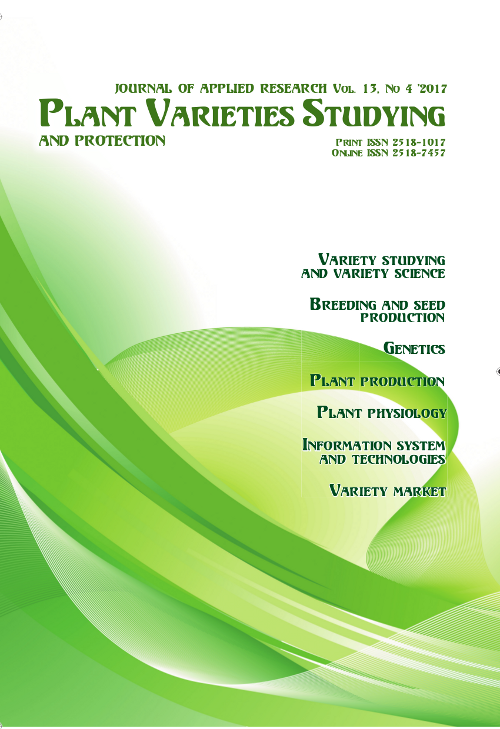Comparative analysis of statistical software products for the qualifying examination of plant varieties suitable for dissemination
DOI:
https://doi.org/10.21498/2518-1017.13.4.2017.117757Keywords:
decision support system, qualifying examination, varieties suitability for dissemination, conditional standard, statistical methods in breeding, dispersion analysis, cluster analysis, R, IBM SPSS StatisticsAbstract
Purpose. To define statistical methods and tools (application packages) for creating the decision support system (DSS) for qualifying examination of plant varieties suitable for dissemination (VSD) in the context of data processing tasks. To substantiate the selection of software for processing statistical data relative to field and laboratory investigations that are included into the qualifying examination for VSD.
Methods. Analytical one based on the comparison of methods of descriptive and multivariate statistics and tools of intellectual analysis of data obtained during qualifying examination for VSD. Comparative analysis of software tools for processing statistical data in order to prepare proposals for the final decision on plant variety application. Decomposition of tasks was carried out which were included into the decision support system for qualifying examination of varieties-candidates for VSD.
Results. Statistical package SPSS, analysis package included in MS Excel and programe language R was compared for the following criteria: interface usability, functionality, quality of calculation result presentation, visibility of graphical information, software cost. The both packages were widely used in the world for statistical data processing, they have similar functions for statistics calculation.
Conclusion. Tasks of VSD were separated and recommended to tackle using investigated tools. Programe language R was a product recommended to use as a tool. The main advantage of R as compared to the package IBM SPSS Statistics is the fact that R is an open source software.
Downloads
References
Metodyka provedennia kvalifikatsiinoi ekspertyzy sortiv roslyn na prydatnist do poshyrennia v Ukraini. Zahalna chastyna [Regulations on the procedure and the conduct of qualification tests for suitability of crop varieties for dissemination in Ukraine. General part]. (2016). Vinnytsia: FOP Korzun D. Yu. [in Ukrainian]
Goryainova, E. R., Pankov, A. R., & Platonov, E. N. (2012). Prikladnye metody analiza statisticheskikh dannykh [Applied methods of statistical data analysis]. Moscow: Vysshaya shkola ekonomiki. [in Russian]
Compton, M. E. (1994). Statistical methods suitable for the analysis of plant tissue culture data. Plant Cell. Tiss. Organ. Cult. Vol. 37, Iss. 3. P. 217–242. doi: 10.1007/BF00042336
Bryman, A., & Cramer, D. (2011). Quantitative Data Analysis with IBM SPSS 17, 18 and 19: A Guide for Social Scientists. New York: Routledge.
Levesque, R. (2007). SPSS Programming and Data Management: A Guide for SPSS and SAS Users. (4th ed.). Chicago, IL: SPSS Inc.
Byuyul, A., & Tsefel, P. (2002). SPSS: iskusstvo obrabotki. Analiz statisticheskikh dannykh i vosstanovlenie skrytykh zakonomernostey [SPSS: Art of Handling. Analysis of statistical data and restoration of hidden patterns]. St. Petersburg: DiaSoftYuP. [in Russian]
Baumer, B. S., Kaplan, D. T., & Horton, N. J. (2017). Modern Data Science with R. Boca Raton: Chapman & Hall/CRC.
Cheshkova, A. F., Aleynikov, A. F., & Stepochkin, P. I. (2016). Application of graphical capabilities of the R programming environment for analysis of experimental data on triticale breeding. Vychislitel’nye tekhnologii [Computational Technologies], 21(1), 104–115. [in Russian]
Kirilenko, Yu., Kuznetsova, Yu., Sokolova, Ye., & Frolova, H. (2013). Methods to estimate the usability of a user’s interface. Visnyk Natsionalnoho universytetutu «Lvivska рolitekhnika». Seriia: Kompiuterni nauky ta informatsiini tekhnolohii [Bulletin of National University “Lvivska Politechnika”. Ser.: Computer Engineering and Information Technologies], 751, 244–256. [in Ukrainian]
Downloads
Published
How to Cite
Issue
Section
License
Copyright (c) 2017 Ukrainian Institute for Plant Variety Examination

This work is licensed under a Creative Commons Attribution-ShareAlike 4.0 International License.
Starting in 2022, the copyright to the publication remains with the authors
Our journal abides by the CREATIVE COMMONS copyright rights and permissions for open access journals.
Authors, who are published in this journal, agree to the following conditions:
- The authors reserve the right to authorship of the work and pass the first publication right of this work to the journal under the terms of a Creative Commons Attribution License, which allows others to freely distribute the published research with the obligatory reference to the authors of the original work and the first publication of the work in this journal.
- The authors have the right to conclude separate supplement agreements that relate to non-exclusive work distribution in the form in which it has been published by the journal (for example, to upload the work to the online storage of the journal or publish it as part of a monograph), provided that the reference to the first publication of the work in this journal is included.

























 Ukrainian Institute for Plant Varieties Examination
Ukrainian Institute for Plant Varieties Examination  Селекційно-генетичний інститут
Селекційно-генетичний інститут Institute of Plant Physiology and Genetics of the National Academy of Sciences of Ukraine
Institute of Plant Physiology and Genetics of the National Academy of Sciences of Ukraine
 The National Academy of Agrarian Sciences of Ukraine
The National Academy of Agrarian Sciences of Ukraine